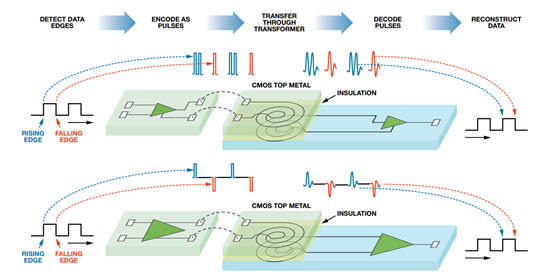The main function of the isolator is to transmit some form of information through the electrical isolation barrier while blocking current. The isolator is made of insulating material, which can block the current, and there are coupling elements at both ends of the isolation barrier. The information is usually encoded by the coupling element before being transmitted through the isolation barrier.
The iCoupler® digital isolator from the circuit board manufacturer ADI uses a chip-scale microtransformer as a coupling element to transmit data through a high-quality polyimide isolation barrier. There are two main data transmission methods used in iCoupler isolators: single-ended and differential. When selecting a data transmission mechanism, engineering design choices need to be made to optimize the required terminal product characteristics.
In single-ended data transmission, we use a transformer, and one end of the primary winding is grounded. The logic conversion code in the input signal is a pulse, which is always positive relative to the ground and is located on the transmitter chip. This is also called "one pulse, two pulses" because the rising edge is encoded as two consecutive pulses, while the falling edge is represented as a single pulse (see the top of Figure 1). The receiver at the other end of the isolation barrier receives the signal and determines whether one or two pulses were sent; it will then reconstruct the output accordingly.
Differential data transmission uses true differential transformers. In this case, when the input edge is detected, a single pulse is always sent, but the polarity of the pulse determines whether the transition is rising or falling (bottom of Figure 1). The receiver is a true differential structure, and the output is updated according to the pulse polarity.

Single-End and Differential Data Transfer
One of the main advantages of the single-ended approach is the lower power consumption at low data rates. This is because differential receivers require more DC bias current than CMOS Schmitt triggers used in single-ended receivers. However, the differential method has lower power consumption at higher throughput rates for two reasons: the drive level and the number of pulses. The drive level of the transformer can be reduced, because the receiver only needs to determine the polarity, and does not need to determine whether there are a single pulse or two pulses. On average, single-ended systems require 1.5 pulses per edge, while differential transmission requires 1 pulse per edge (a reduction of 33%).
Reduced drive level and fewer pulses can also reduce radio frequency radiation. The reason for the radiation is that the current pulse in the power supply causes the radiation of the printed circuit board structure. Since there are fewer pulses and the energy of each pulse is lower, the radio frequency radiation generated is significantly reduced.
Compared with single-ended systems, differential transmission has two other advantages: propagation delay and immunity. In the single-ended method, when creating a single pulse or two pulses, there must be a specific timing relationship, and the receiver must analyze the pulses within a specific time window. These requirements put restrictions on encoding and decoding, and ultimately limit the propagation delay through the device. This in turn limits the total throughput that the device can achieve. The differential method is less restricted because it always uses a single pulse, so the propagation delay is lower and the throughput is higher.
The differential receiver can reliably detect the differential signal sent by the transmitter, and also suppress the useless common mode noise that is ubiquitous in the isolation system, resulting in a significant improvement in common mode transient immunity (CMTI). Differential receivers are not too susceptible to power supply noise, and therefore have higher immunity. The LED used in the optocoupler is essentially single-ended, which is one of the reasons why the CMTI performance of the optocoupler is usually poor. Differential data transmission enables the performance of iCoupler digital isolators to be significantly improved compared to optocouplers.
The data transmission method is also an option for designers to optimize the performance of digital isolators. Using true differential coupling elements as the basis of iCoupler technology can provide high flexibility in this respect, which is also usually unattainable by optocouplers and capacitive coupling devices.